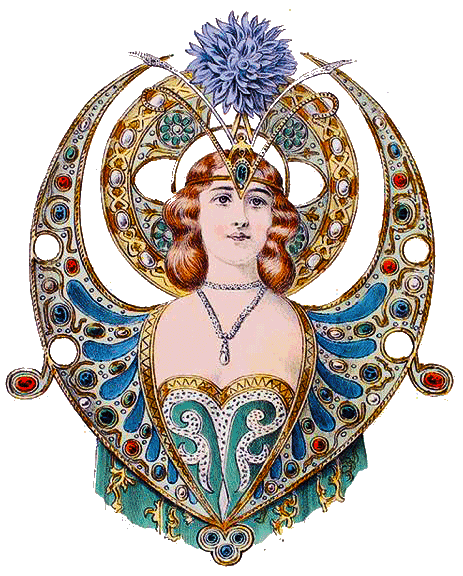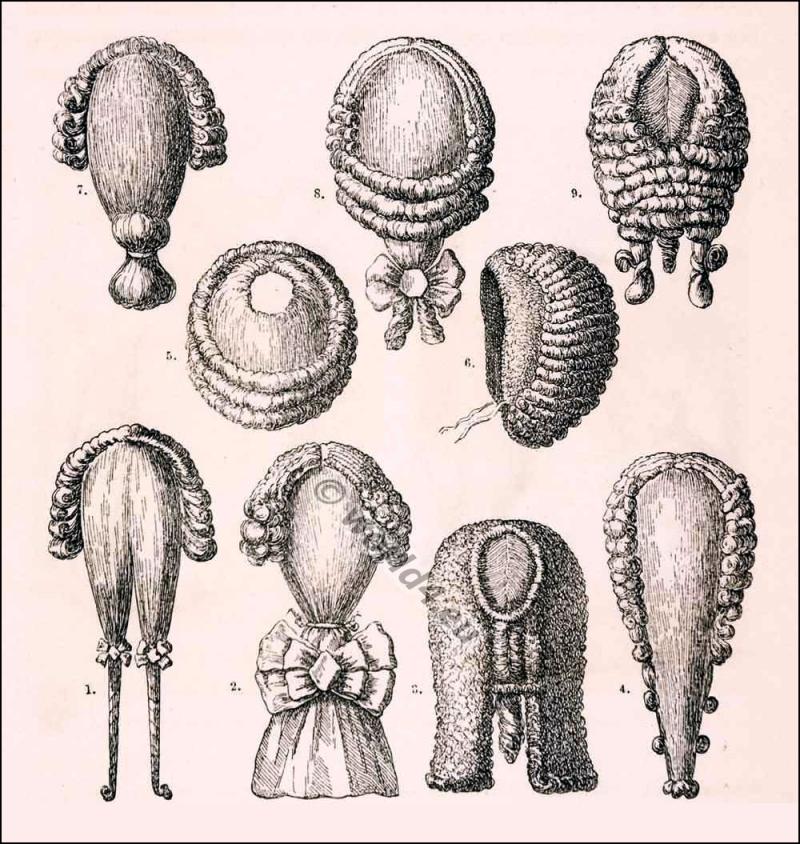THE EIGHTEENTH CENTURY SILHOUETTES
EVEN as we revert to the old-period costumes for ideas and suggestions for our present day wardrobe, the leaders of fashion in the eighteenth century turned for inspiration to the sixteenth century and later, to classical Greece and Rome.
About the year 1718 the hoop returned to popular favour, becoming the dominant feature of the eighteenth century costume up to the Revolutionary period (1789-1799).
The panier, as the hoop was then called, was at first of moderate size but soon became of exaggerated width at the sides, still remaining flat in front and back. It was worn with the one-piece princess dress which hung semi fitting in front, and with plaits from the shoulders to the ground in the back, the dress pictured so frequently by Watteau in his exquisite canvases.
Of the two-piece costume consisting of an elaborately decorated skirt and tight, pointed bodice with its short sleeves and square or rounding neckline, the panier was also an important feature. The skirts were frequently short in order to display the dainty clocked stockings and high-heeled slippers with their accompanying buckles at the instep.
In the early part of the period of Louis XV the hair was dressed very simply; waved and combed back from the forehead. It remained, however, for Marie Antoinette and her ladies to introduce the elaborate coiffures and extreme head-dresses, which call to mind the absurdities of the Middle Ages.
On top of the elaborate erections of gauze and puffs were placed feathers, ribbons, flowers, and curious ornaments representing landscapes, ships or events of a political or social nature.
The materials of this century were generally simpler in design, of more delicate values, and lighter in effect than the gorgeous fabrics of the preceding one. Taffetas, plain, striped, and small patterned, came into fashion during the reign of Louis XV and were admirably suited to the puffs and draperies of Milady’s gown. The heavy Venetian and French point laces, being too heavy for the delicate new fabrics, were replaced by the lighter French and Flemish laces such as Point d’Alençon, Valenciennes, and Mechlin which added grace and delicacy to this exaggerated but withal charming costume.
With the French Revolution there came the natural reaction away from everything favoured by the former monarchy. Costly materials, the corset, and the panier were alike discarded, and women, in their effort to obtain something entirely different, turned to a period far removed. The excavations of Pompeii and the campaigns of Napoleon taking place at that time in the countries of the Mediterranean turned popular attention to classical civilisation, and by the time of the Directorate, 1795-1799, we see the third great change in silhouette, one based on the garments of Greece and Rome.
The short waist and tiny sleeve, the long, straight, and narrow skirt of simple, inexpensive muslin, lawn, and India prints became the fashion of the day. The hair dressing was a more or less faithful reproduction of that of the old Greek and Roman statues, though for some devotees of the new order long hair was a thing of the past, short hair à la Titus being the vogue. The shorn locks of the victims of the guillotine were the direct inspiration of this particular mode of hair dressing, known also as the coiffure “à la Victime”.
QUESTIONS
- Make a study of the costume silhouette of the American women, during the period of the Revolution. How does it differ from that worn by the French women, at the same time?
- Compare carefully Fig. 10 with Fig. 12, from the point of view of:
a. Picturesqueness.
b. Practicability.
c. Healthfulness. - Would you favor a revival of the style of hairdressing fashionable during the reign of Marie Antoinette? If not, give reasons for your objections.
- What effect would a silhouette similar to that of Fig. 11 have on a short, stout person?
- What type of person would the lines of the silhouette in Fig. 12 suit?
- On what occasions could a gown, with a silhouette adapted from that of Fig. 10 be worn today? Make sketches of several gowns, showing adaptations of this silhouette, for members of your class.
- Make a list of famous characters of fiction, whom you remember described as wearing this type of costume.
Costume silhouettes by Mary Evans. Philadelphia, J.B. Lippincott Company 1923.

Continuing
Discover more from World4 Costume Culture History
Subscribe to get the latest posts sent to your email.










